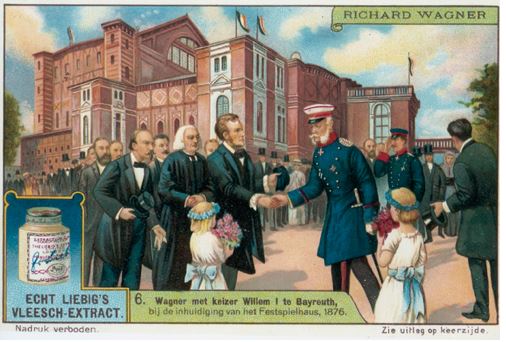
The Giving of Gifts
It is appropriate that today, on St. Valentine’s Day, we celebrate a piece of music given as a gift of love from a husband to his wife: Richard Wagner’s Siegfried Idyl, which was given as a birthday gift to his wife Cosima in 1870.
Yesterday’s Music History Monday post marked the 140th anniversary of the death of Wagner (1813-1883) in Venice, at the age of 69. As we observed in that post, Venice was, for Wagner, a spiritual and artistic refuge, a place of uncanny physical beauty and – lacking any sort of wheeled transportation – uncanny quiet, a place where Wagner could presumably remove himself from the anxiety, hyperactivity, over-excitability, and depression that dogged his adult live.
Presumably.
On September 14, 1882, following the premiere run at the Bayreuth Festival (in southern Germany) of what turned out to be Wagner’s last work, Parsifal, Wagner, his family, and his entourage decamped for Venice. There they took over the entire mezzanine floor of one of Venice’s greatest palazzi: the late fifteenth-century Palazzo Vendramin-Calergi on the Grand Canal.
On arriving in Venice, Wagner expressed the wish that he would die in Venice, a classic instance of “be careful what you wish for.” He did indeed pass away there in Venice, some five months later, on February 13th, 1883. But before he died – of a heart attack – he participated in what had become a Wagner family tradition, the giving of a musical gift to his wife Cosima on the occasion of her birthday.
Cosima Liszt von Bülow Wagner was born late on Christmas eve of 1837, but she always celebrated her birthday on Christmas day. For those good people who celebrate the Christmas holiday and were additionally born on Christmas day, this can be – in terms of a birthday celebrations – a small disaster: instead of having separate celebrations and receiving separate birthday and Christmas gifts, it is my impression that for such people, everything gets rolled into a single celebration (and single gifts!).
(For our information, among other notable people who celebrate their birthdays on December 25 were/are Clara Barton, Humphrey Bogart, Jimmy Buffett, Conrad Hilton, Annie Lennox, Sissy Spacek, Kenny Stabler, and Justin Trudeau.)
Despite his ailing heart, Wagner continued his musical gift-giving tradition in December of 1882, when, in honor of Cosima’s 45th birthday, he conducted his early C Major Symphony at La Fenice (Venice’s principal opera house) to an invitation-only audience on Christmas eve.
(The symphony was composed in 1832 when was Wagner was 19 years old. A complete performance by the Berlin Radio Symphony Orchestra conducted by Heinz Rögner is linked below.)
The Siegfried Idyl and its Dedicatee: Cosima Liszt von Bülow Wagner (1837-1930)

We read – here and there, over-and-under, around and about – that “Wagner wrote almost no instrumental music.” This is a mostmisleading statement, as Wagner was in fact a brilliant composer of instrumental music for orchestra, and he did indeed compose a significant body of orchestral music. However, it just so happens that the overwhelming bulk of that orchestral music was incorporated into his stage works as overtures, entr’actes, interludes, codas, etc. So let’s rephrase that just-quoted statement to read this way: “in his maturity, Wagner wrote very few self-standing, instrumental compositions, the most famous of which is his Siegfried Idyll.”
Siegfried Idyll is an exquisite work, with a fabulous back-story, and after all, how often do we get to hear and revel in a Wagnerian opus that runs but 20 minutes from beginning to end? Exactly. And it just so happens that the Siegfried Idyl was a gift from Wagner to his wife, Cosima, on the occasion of her 33rd birthday, on December 25, 1870.…
Continue reading, only on Patreon!
Become a Patron!